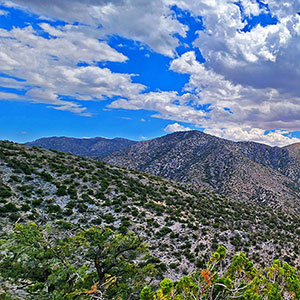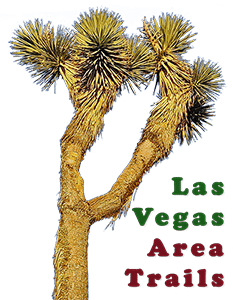North Ridge of South Spring Canyon | Lovell Canyon, Nevada
Blue map lines are proven by test.
Purple lines still to be explored to select the best route.
Gray lines have been explored. Barriers found.
First Ridge Explored: 20ft Barrier Ledge at 6,300ft
Overview | North Ridge of South Spring Canyon | Lovell Canyon, Nevada
The original goal was is to locate a good ascent route from Lovell Canyon to The Rainbow Mountains Upper Crest Ridgeline above Juniper Peak, then take the Ridgeline from Juniper Peak to Mt. Wilson. Finally, descend the Ridgeline from Mt. Wilson to Saltgrass Road, then descend Saltgrass Road back to its intersection with Lovell Canyon Road, the Start/End point. Various routes are mapped out on the map on this page. The gray route is the route taken today. Though turned around by a barrier at about 7,000ft on the ridge, there were some great discoveries!
Why a Juniper Peak to Mt. Wilson circuit adventure?
- Largest Remaining Ridgeline Stretch: This will complete the largest remaining stretch on The Rainbow Mountains Upper Crest Ridgeline.
- One-Car Strategy: By taking the Ridgeline by sections, this enables one to complete the entire Upper Crest Ridgeline in a series of out-and-back adventures using only one car parked at various route start/end points. The alternate strategy would be a 2-car approach parking one car at Willow Spring in Red Rock Canyon (the Northern end of The Ridgeline) and the other car at Mountain Spring Trailhead on Highway 160 (the Southern end of The Ridgeline).
- See this page for links to each separate stretch on The Upper Crest Ridgeline.
- Exploration of Lovell Canyon Tributary Canyons and Ridges: In the process of completing these individual stretches on The Upper Crest Ridgeline, many of the major tributary ridges and canyons on the Eastern side of Lovell Canyon are explored and documented.
- Beautiful, Untouched Wilderness: It’s all incredibly beautiful wilderness and every adventure brings new discoveries. Much of the ground covered is seldom if ever traversed by humans.
- Experience One Interconnected Wilderness: The Rainbow Mountain Wilderness ends up being documented as a complete whole, all parts interconnected.
First Ridge Explored: 20ft Barrier Ledge at 6,300ft
The first ascent ridge explored between Lovell Canyon and The Rainbow Mountains Upper Crest Ridgeline above Juniper Peak had a large barrier ledge at the 6,300ft point on the intervening Wilson Ridge, just 500ft in elevation below The Upper Crest Ridgeline! It was a beautiful, gradual ridge passing through a number of plant zones from desert sage to high Juniper and Pine zone. There were some pretty amazing fossils on this ridge. The ridge also revealed views of surrounding approach ridge alternatives.
Approach Ridge Spectacular Views
Like the other ridges on the Eastern end of Lovell Canyon that ascend to The Rainbow Mountains Upper Crest Ridgeline, there are spectacular views of the surrounding wilderness including Mt. Charleston Wilderness to the North with Griffith Peak, Charleston Peak, Mummy Mountain and Harris Mountain; Potosi Mountain to the South; possibly Telescope Peak above Death Valley to the West; and the entire North/South extent of Lovell Canyon.
Best Time of Year for Adventures on The Rainbow Mountains Upper Crest Ridgeline and its Approach Ridges
Try to stick to Spring or Fall, when the temperature in Las Vegas is below 90 degrees. Summer can bring temperatures in excess of 110 degrees and Winter can bring snow and icy conditions on the approach ridges and The Upper Crest Ridgeline. A good rule of thumb (at least in my own experience) is that with every 1000ft elevation gain the temperature drops about 5 degrees. Thus 90 degrees in Las Vegas means about 80 degrees in Lovell Canyon and 70 degrees on The Upper Crest Ridgeline.
Trailhead Directions | North Ridge of South Spring Canyon | Lovell Canyon, Nevada
Take Hwy 160 from Las Vegas toward Pahrump. The highway ascends over a “hump” (the Potosi Mountain area). There’s a saying around here, “Over the hump to Pahrump”. Well, you’ve just traveled over that hump. Around 4-5 miles from the point where the highway begins to descend toward Pahrump there is a well-marked sign on the right for Lovell Canyon Road.
Locating the Intersection of Lovell Canyon Road and Saltgrass Road
Proceed a couple miles up the well-paved road to Lovell Canyon Campground. You will park at the intersection of Lovell Canyon Road and Saltgrass Road which will be on the right. However, there is no sign that says “Saltgrass Road”. Your only indication that you are at the intersection of Lovell Canyon Road and Saltgrass Road is a small marker on the right indicating Road: #45540. If you’re going to proceed from this point on foot, find a place to park near that intersection. Saltgrass Road, #45540. is the best starting point for this adventure.
Route Observations | North Ridge of South Spring Canyon | Lovell Canyon, Nevada
First Ridge Explored: 20ft Barrier Ledge at 6,300ft
Start/End Point at Lovell Canyon & Saltgrass Roads
I began from the lower Lovell Canyon Campground at the intersection of Lovell Canyon Road and Saltgrass Road. My goal was to ascend Lovell Canyon Road, locate an approach ridge to The Rainbow Mountains Upper Crest Ridgeline summiting above Juniper Peak, take The Upper Crest Ridgeline South to Mt. Wilson, then descend ridges and canyons to the upper end of Saltgrass Road and finally back to Lovell Canyon Road.
Road 548 and the South Ridge of South Spring Canyon (route not taken today)
I began ascending Lovell Canyon Road to a high point before it takes a winding plunge downward. You’ll know when you hit that spot about a mile above the intersection with Saltgrass Road. At that high point there is a good potential approach ridge beginning from road 548 that splits off to the right from Lovell Canyon Road. I did not take that approach ridge on this first exploration day, though it is my next choice.
Winding Descent Down Lovell Canyon Road to the Ridge North of South Spring Canyon
Instead, I descended Lovell Canyon Road in it’s winding downward plunge. There is a canyon right at the bottom of this plunge. South Spring is located in the canyon, so the canyon name may be South Spring Canyon. See the map on this page. I did not take South Spring Canyon toward The Upper Crest Ridgeline, having heard from one of my video viewers that the canyon had barriers of bees, brush and ledges. Besides, I try to avoid canyon washes due to the characteristic deep gravel surface and limited visibility.
Begin Ascending the North Ridge of South Spring Canyon.
However, there is a ridge on the North side of South Spring Canyon. This is The Rainbow Mountains Upper Crest Ridgeline approach ridge I took during this initial exploration. It began very well: Gradual steady incline. Spectacular expanding views up and down Lovell Canyon from Potosi Mountain to The Mt. Charleston Wilderness. Feeling of being the only person ever to ascend this ridge.
Ancient Fossils
Ancient fossils (around 450M-years old) began to appear around the 6,000ft level on the ascent ridge. My experience of Lovell Canyon ascent ridges to the Wilson Ridge has been that many of the ascent ridges have limestone embedded with ancient fossils about this same altitude.
Spectacular Views, Junipers and Pines
The limestone veins became more and more pronounced, becoming ledges. As the ledges at first ran parallel to the ridgeline, they simply added a rustic beauty. At around 5,500ft the ridge became populated with beautiful junipers and pines, and the surrounding rocks and ledges were a beautiful gray and bronze. The views became more and more expansive! Every time it looked as if the next height might be the end of the ridge, the ridge continued upward beyond. It was a fun unfolding discovery!
Barrier Ledge at 6,300ft on the North Ridge of South Spring Canyon
However, I eventually reached a real barrier at 6,300ft on the Wilson Ridge (just 500ft in elevation below The Rainbow Mountains Upper Crest Ridgeline). There was a shallow saddle between the ridge I was on and the neighboring ridge to the North, which looked as if it was continuing to ascend upward toward The Rainbow Mountains Upper Crest Ridgeline. In fact, I could now see portions of The Upper Crest Ridgeline possibly less than a mile away to the East! In addition, besides that alternate approach ridge to the North, which had a nice gradual ascent, there was that other neighboring approach ridge on the South side of South Spring Canyon.
The problem was that there was a 20ft limestone ledge at the edge of the saddle. I explored up and down the ledge line. It continued in both directions unbroken. Now, and experienced rock climber might laugh at the fact that this ledge stopped me. There were places along the ledge where a semi vertical (class 4) descent seemed possible. But I was alone in an isolated area without rock climbing experience or gear. A fall, though probably not fatal, could create an injury that would make it hard to descend back to Lovell Canyon Road, along with presenting a month or more of recovery. Though that neighboring ascent ridge to the North was so close…an easy walk after descending the 20ft ledge, I turned around and retraced my way descending the current ridge back to Lovell Canyon Road.
Two Alternate Ascent Ridges from Lovell Canyon to The Rainbow Mountains Upper Crest Ridgeline Above Juniper Peak
Two alternate ridges to attempt (one to the North, one to the South), and uninjured! I’ll return and probably attempt the approach ridge on the South side of South Spring Canyon. In the video I cautioned against this ridge to the South, but the more I later studied the map, the better it began to look as the next hopeful alternative! Take Road 548 before Lovell Canyon Road suddenly winds downward. Road 548 leads to the South ridge of South Spring Canyon. Ascend that ridge to near The Rainbow Mountains Upper Crest Ridgeline, weave around a bit before reaching the final ascent point to The Upper Crest Ridgeline. Turn North on the Ridgeline for about a half-mile to the area above Juniper Peak, then turn South on the Ridgeline for a couple miles to the area above Mt. Wilson. See and expand the map on this page.



